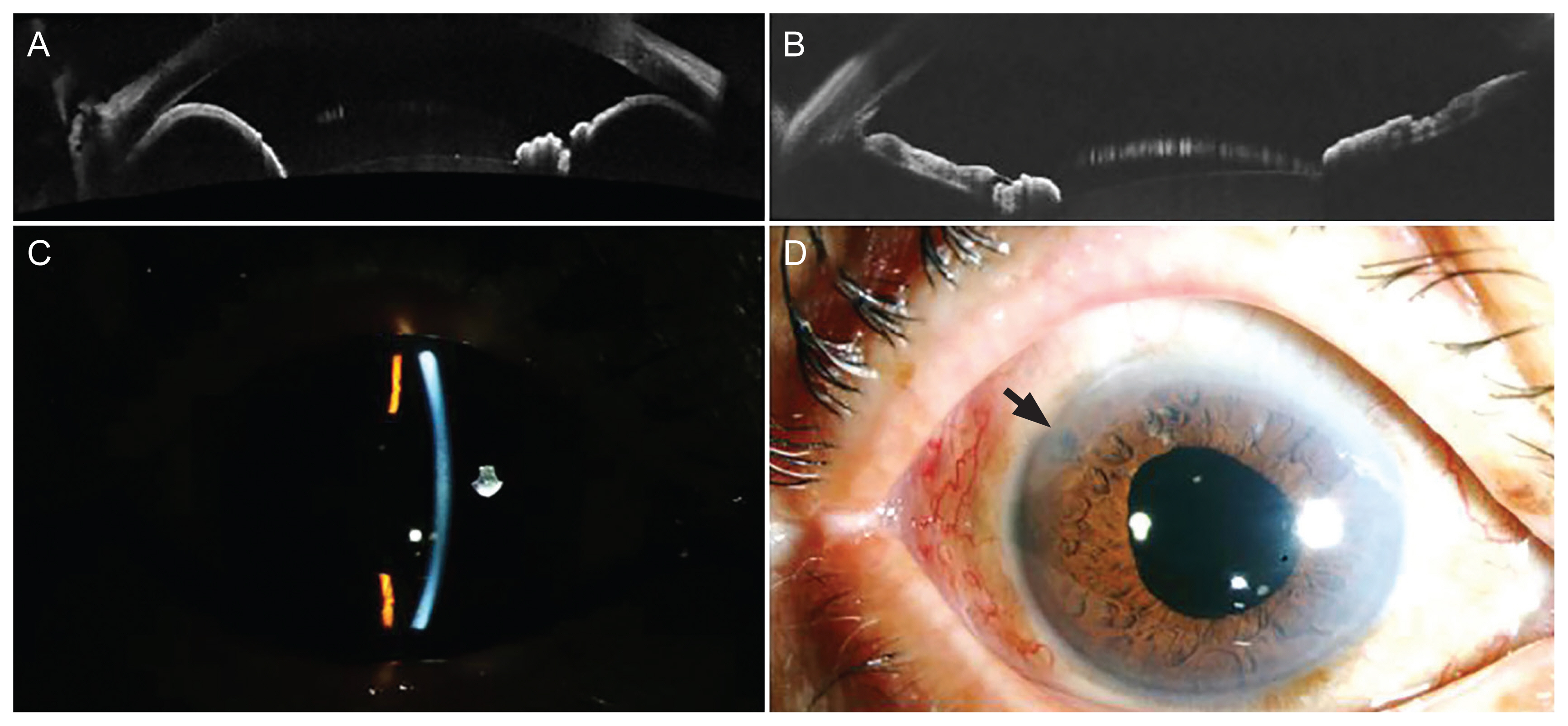Pseudophakic Pupillary Block with Acute Angle Closure Following Vitrectomy in an Adult Microphthalmia with Diabetic Retinopathy: Case Report
Article information
Dear Editor,
The combination of phacoemulsification and posterior chamber (PC) intraocular lens (IOL) implantation has been considered the treatment option for patients with primary angle closure (PAC) disease, as it relieves pupillary block, the predominant mechanism of PAC. Some patients, however, develop the pseudophakic pupillary block even after uncomplicated surgery. Herein, we reported the case of an adult with microphthalmia, which presented as transient myopic shift and pseudophakic pupillary block with PAC after pars planar vitrectomy (PPV).
A 62-year-old male patient was referred for elevated intraocular pressure (IOP) and myopic shift in his right eye. At 3 months ago, he had been performed phacoemulsification with PC IOL implantation (Zeiss 204M +35.0 diopters [D]) and PPV, tractional membrane removal, and silicone oil (SO) injection for proliferative diabetic retinopathy. Preoperative AC depth (ACD), distance between the corneal epithelium and anterior lens surface, was 2.37 mm in both eyes and the axial lengths in his right and left eyes were 18.87 and 19.00 mm, respectively. The refractive error was +0.25 D at 1 week after the surgery. Since his retina had remained stable after the primary surgery, the filled SO had been removed 3 weeks before the glaucoma clinic visit.
At the presentation, best-corrected visual acuity was 20 / 200 in his right eye (−2.75 D) and the IOP was 35 mmHg in the right eye. A shallow AC with iris bombe (Fig. 1A) and posterior synechiae between the pupillary margins and the IOL were observed. The AC angle was closed with focal peripheral anterior synechiae on the gonioscopic examination. However, there were no evidences of new vessels on the iris or angle. He had never been diagnosed with glaucoma prior to the surgery. Under the diagnosis of a pseudophakic pupillary block, he was performed laser peripheral iridotomy and shortly after that, the AC deepened and the iris bomb was resolved (Fig. 1B–1D). At 4 days after the treatment, the myopic shift was also resolved (+0.75 D) and there was no remained SO in the AC. Although the heavy trabecular meshwork pigmentation with focal peripheral anterior synechiae was observed, the trabecular meshwork was easily visualized in 360°AC angle. At 2 months of the peripheral iridotomy, his vision improved up to 20 / 40 (+0.50 D) and IOP was 13 mmHg without any antiglaucoma medications.

Changes in the anterior segment following the laser peripheral iridotomy (PI). Anterior segment optical coherence tomography images (A) before and (B) immediately after laser PI. (C,D) slit-lamp photographs taken 1 day after laser PI of the right eye of this patient. (A) Anterior segment optical coherence tomography showed an iris bombe with iridocorneal touch at the pupillary block with angle closure glaucoma. (B) Immediate after laser PI, the iris bombe was resolved and peripheral anterior chamber was deepened. (C,D) One day after laser PI, slit-lamp examination showed deep anterior chamber and patent PI site at 10.5 o’ clock (arrow). Informed consent for publication of the clinical images was obtained from the patient.
Pseudophakic pupillary block is caused by the blockage of aqueous flow through the pupil. The block rarely occurs when an IOL is implanted into the bag. However, it can occur immediately or years after uneventful PC IOL implantation in eyes with excessive postoperative inflammation leading the formation of posterior synechiae/adhesions between the pupillary margins and the anterior surface of IOL [1]. Diabetes mellitus (by breaking the blood-aqueous barrier), retained lens material behind the iris, free vitreous block, and blockage by SO are the risk factors for the block [2–4].
Microphthalmia, characterized by the shallow AC and a thick sclera, is a known risk factor for the pupillary block after cataract extraction surgery. Zheng et al. [4] reported that the preoperative ACD is an important predictive factor for the postoperative block in such patients; the shallow preoperative AC under <1.5 mm increased the risk of postoperative angle closure, whereas no blockage was observed in eyes with deeper (>2.00 mm) preoperative ACD. In the present case, the preoperative ACD was 2.30 mm, the IOL was inserted into the capsular bag, and the lens materials, vitreous, and SO were well removed. The pupillary block with myopic shift, however, occurred 3 weeks after the SO removal. Since microphthalmia have a risk of ciliary body/uveal effusion, the swelling of the ciliary body, accelerated by PPV, might be the possible explanation for PAC and transient myopic shift (anterior shifting of lens-iris diaphragm) in this case. The ciliary body swelling resulted in forward movement of the IOL and friction/adhesions between the iris and the anterior surface of the IOL. As a result, the pupillary block and myopic shift might have concurrently occurred in this patient. Although the remained SO bubble could cause the angle closure [5], the SO was not observed in our case.
In conclusion, the pseudophakic pupillary block could occur even after uncomplicated PPV in microphthalmic eyes. Therefore, patients with risk factors for pseudophakic block should be carefully monitored after PPV.
Notes
No potential conflict of interest relevant to this article was reported.